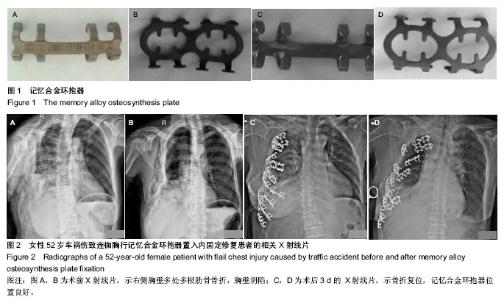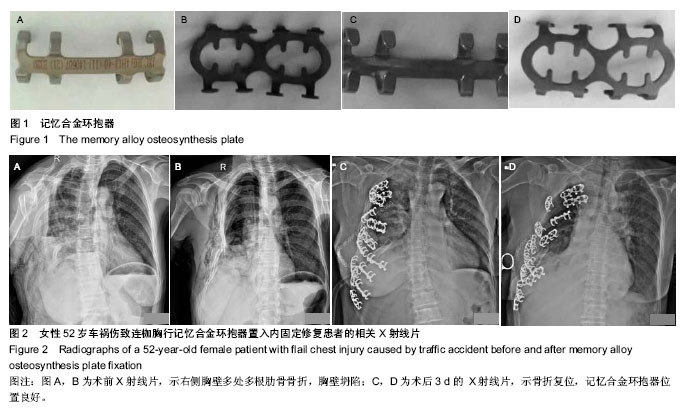| [1] 文毅,陈光春,廖小勇,等.镍钛记忆合金环抱器手术治疗多发性肋骨骨折及连枷胸的临床研究[J].创伤外科杂志,2009,11(3): 203-205.
[2] 徐恩五,乔贵宾,彭秀凡,等.记忆合金环抱器固定肋骨骨折的适应证及手术技巧[J].中华创伤杂志,2012,28(6):533-536.
[3] 刘虎,薛宏斌,许瑞彬,等.肋骨接骨板内固定治疗连枷胸的临床观察[J].中国现代医学杂志, 2012, 22(13):99-100.
[4] Althausen PL, Shannon S, Watts C, et al. Early surgical stabilization of flail chest with locked plate fixation. J Orthop Trauma. 2011;25(11):641-647.
[5] 詹惟,李建波,夏强,等.中老年多发伤并连枷胸患者治疗中微创外科手术技术的应用[J].中国老年学杂志,2013,33(22): 5589-5590.
[6] Nirula R, Diaz JJ Jr, Trunkey DD, et al. Rib fracture repair: indications, technical issues, and future directions. World J Surg. 2009;33(1):14-22.
[7] Solberg BD, Moon CN, Nissim AA, et al. Treatment of chest wall implosion injuries without thoracotomy: technique and clinical outcomes. J Trauma, 2009, 67(1):8-13.
[8] 徐新建,何明.连枷胸的肋骨固定治疗及进展[J]. 国际外科学杂志, 2011,38(1):63-65.
[9] Lafferty PM, Anavian J, Will RE, et al. Operative treatment of chest wall injuries: indications, technique, and outcomes. J Bone Joint Surg Am. 2011;93(1):97-110.
[10] Mouton W, Lardinois D, Furrer M, et al. Long term follow-up of patients with operative stabilization of a flail chest. J Thorac Cardiovasc Surg. 1997; 45(5):242-244.
[11] Mayberry JC, Kroeker AD, Ham LB, et al. Long-term morbidity, pain, and disability after repair of severe chest wall injuries. Am Surg. 2009;75(5):389-394.
[12] Lardinois D, Krueger T, Dusmet M, et al. Pulmonary function testing after operative stabilization of the chest wall for flail chest. Eur J Cardiothorac Surg. 2001;20(3):496-501.
[13] 李善平,余悍东,张道鑫,等.连枷胸内固定手术方法的临床应用比较[J].中国胸心血管外科临床杂志, 2011,18(1):83-85.
[14] 李新亚,高峰,王刚,等.记忆合金环抱接骨板治疗多根多处肋骨骨折的临床研究[J].解剖与临床,2012,17(6):501-504.
[15] 肖志明,马杰,翟永富,等.记忆合金环抱器在创伤性连枷胸治疗中的应用[J].中国胸心血管外科临床杂志,2012,19(5):572-573.
[16] 胡剑鹏,吴吉明,陈德祥,等.连枷胸手术固定与非手术固定的临床研究[J].医学临床研究,2012,29(4):694-696.
[17] 汪方清,胡卫建,陈胜,等.镍钛记忆合金环抱形肋骨接骨板治疗无连枷胸多发肋骨骨折对呼吸功能的影响[J].安徽医药,2012, 16(6):793-795.
[18] 韦新宁.镍钛记忆合金肋骨环抱接骨板内固定治疗连枷胸[J].中华临床医师杂志(电子版),2012,6(19):6137-6138.
[19] 陈希涛,孙筱笛,韩立波,等.双侧连枷胸合并严重肺挫伤21例的呼吸机治疗体会[J].临床肺科杂志,2013,18(2):253-254.
[20] 高劲谋,都定元,刘朝普,等.伴多发伤连枷胸的损伤控制外科治疗[J].中华创伤杂志,2013,29(4):343-347.
[21] 苏志勇,姜天烁,张镱镭,等.肋骨骨折分区对外科手术的指导意义[J].中华胸心血管外科杂志,2014,30(7):415-416.
[22] 梁吉祥,杨景魁,郑广钧,等.肋骨接骨板结合“T”形锁定加压钢板治疗连枷胸[J].中华创伤杂志,2014,30(6):519-521.
[23] 王建柏,高劲谋,都定元,等.81例创伤性连枷胸的救治[J].重庆医学,2013,42(28):3434-3435.
[24] 鹿兴,郑锴,张鹏,等.重度损伤合并连枷胸临床治疗对比分析[J].创伤外科杂志,2013,15(1):19-22.
[25] 孟凡青.镍钛记忆合金肋骨爪环抱器在多发肋骨骨折和连枷胸治疗中的应用[J].中国基层医药,2014,21(15):2325-2326.
[26] 杨继承,袁跃西,王少强,等.创伤性连枷胸手术治疗与保守治疗的疗效对比[J].中国医师杂志,2013,15(10):1413-1415.
[27] 滕继平,杨志胤,倪达,等.重症连枷胸手术与非手术治疗的临床对比研究[J].创伤外科杂志,2014,16(2):104-108.
[28] 王雪海,甘崇志,谢家勇,等.影响连枷胸预后的因素(附226例临床分析)[J].四川医学,2013,34(3):312-314.
[29] 刘晋梁,李克耀,何建宁.可吸收肋骨钉在多发性肋骨折内固定中的应用[J].中国修复重建外科杂志,2011,25(1):100-103.
[30] 黄国胜.可吸收固位钉治疗多发性肋骨骨折[J].中国组织工程研究与临床康复,2011,15(4):725-728.
[31] 刘青,王波.记忆金属胸部护板与传统固定方法治疗多发肋骨骨折的比较[J].中国组织工程研究与临床康复,2010,14(17): 3197-3200.
[32] 李智成,王长涛,薛冰,等.肋骨接骨板置入内固定治疗肋骨骨折39例:同一机构2年资料回顾[J].中国组织工程研究与临床康复, 2010,14(22):4155-4159.
[33] 张业强,晏大学,陈娟,等.环抱式爪形肋骨接骨板在连枷胸治疗中的临床应用[J].临床外科杂志,2013,21(12):977-978.
[34] 李书新,姜明明,张子忠,等.记忆环抱器肋骨内固定术治疗创伤性连枷胸68例[J].山东医药,2014,58(15):104-105.
[35] Ahmed Z, Mohyuddin Z. Management of flail chest injury: internal fixation versus endotracheal intubation and ventilation. J Thorac Cardiovasc Surg. 1995; 110(6):1676-1680.
[36] Mayberry JC, Terhes JT, Ellis TJ, et al. Absorbable plates for rib fracture repair: preliminary experience. J Trauma. 2003; 55(5):835-839.
[37] 汪治臻,向小勇,都定元,等.连枷胸的诊治进展[J].创伤外科杂志, 2014,16(3):286-289.
[38] 刘永靖,于奇,朱捷,等.纯钛肋骨接骨板治疗连枷胸和多发性肋骨骨折[J].中华创伤杂志,2013,29(7):650-652.
[39] 王继华,张建,樊建坤,等.肋骨内固定联合机械通气治疗创伤性连枷胸合并肺挫伤[J].河北医药,2014,43(3):361-363.
[40] 滕继平,倪达,程佑爽,等.急诊手术内固定对创伤性连枷胸患者血流动力学的影响[J].上海交通大学学报(医学版), 2010,30(12): 1486-1489.
[41] Freedland M, Wilson RF, Bender JS, et al. The management of flail chest injury: factors affecting outcome. J Trauma. 1990;30(12):1460-1468.
[42] Tanaka H, Yukioka T, Yamaguti Y, et al. Surgical stabilization of internal pneumatic stabilization? A prospective randomized study of management of severe flail chest patients. J Trauma. 2002;52(4):727-732. |

